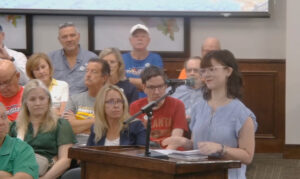With several options for dredging Lake Peachtree on the table, the Peachtree City Council wants to get public input before proceeding with a course of action.
The Fayette County Water System, which uses the city-owned lake as a water source, is contractually obligated to dredge out silt every 10 years, and a recent survey showed about 65,000 cubic yards need to be removed, according to city public works director Mark Caspar.
The last time the lake was dredged in 2003, some 32,000 cubic yards were removed and it took three to four months, Caspar said. That involved using barges to pump out the silt onto Drake Field so it could dry and then be loaded onto trucks and disposed of off-site, he noted.
While that is an option again this time, there is concern that the process will take longer, Caspar said. And tying up Drake Field would interfere with some major city events that use the space including the Dragon Boat Race and International Festival and also the adult triathlon, he noted. Drake Field is also the site where the city’s July 4 fireworks display originates and thus a relocation would be required, Caspar noted.
So a second option that seemed more palatable is one that would pump the silt to create a new island on the lake north of the Battery Way boat docks or put some of the silt there and the rest on the existing island that was created in the 1980s when the lake was dredged.
A new island would create another area that could be used by citizens wanting to view the annual July 4 fireworks show, Caspar noted.
Councilwoman Kim Learnard, who noted that she lived on Lake Peachtree, said she was concerned about reducing the storage capacity of the lake, and Mayor Don Haddix said he shared that concern. Later in the meeting, City Engineer David Borkowski said that is not a problem for the water system, since Lake Peachtree is quite small compared to the other reservoirs used by the water system.
Borkowski noted that the only time the county can reduce the lake pool level is if a drought is declared and Lake Kedron to the north, which feeds into Lake Peachtree, is almost completely empty.
A third option presented by Caspar is to pump the silt directly into trucks to haul it away without dewatering the product. Doing so, however, would be far more expensive and it also would be difficult to contain the watery silt in the truck, Caspar said.
The final option is to avoid the dredging, which may not be as practical since there are some areas of the lake where the water only goes down two feet deep, and ultimately that will lead to the growth of aquatic vegetation, Caspar said.
Since the silt is basically double the amount of the previous dredging, Learnard asked if staff knew what was causing it.
Borkowski said his best guess without a sediment analysis is that the silt is coming from stream bank erosion.










Leave a Comment
You must be logged in to post a comment.